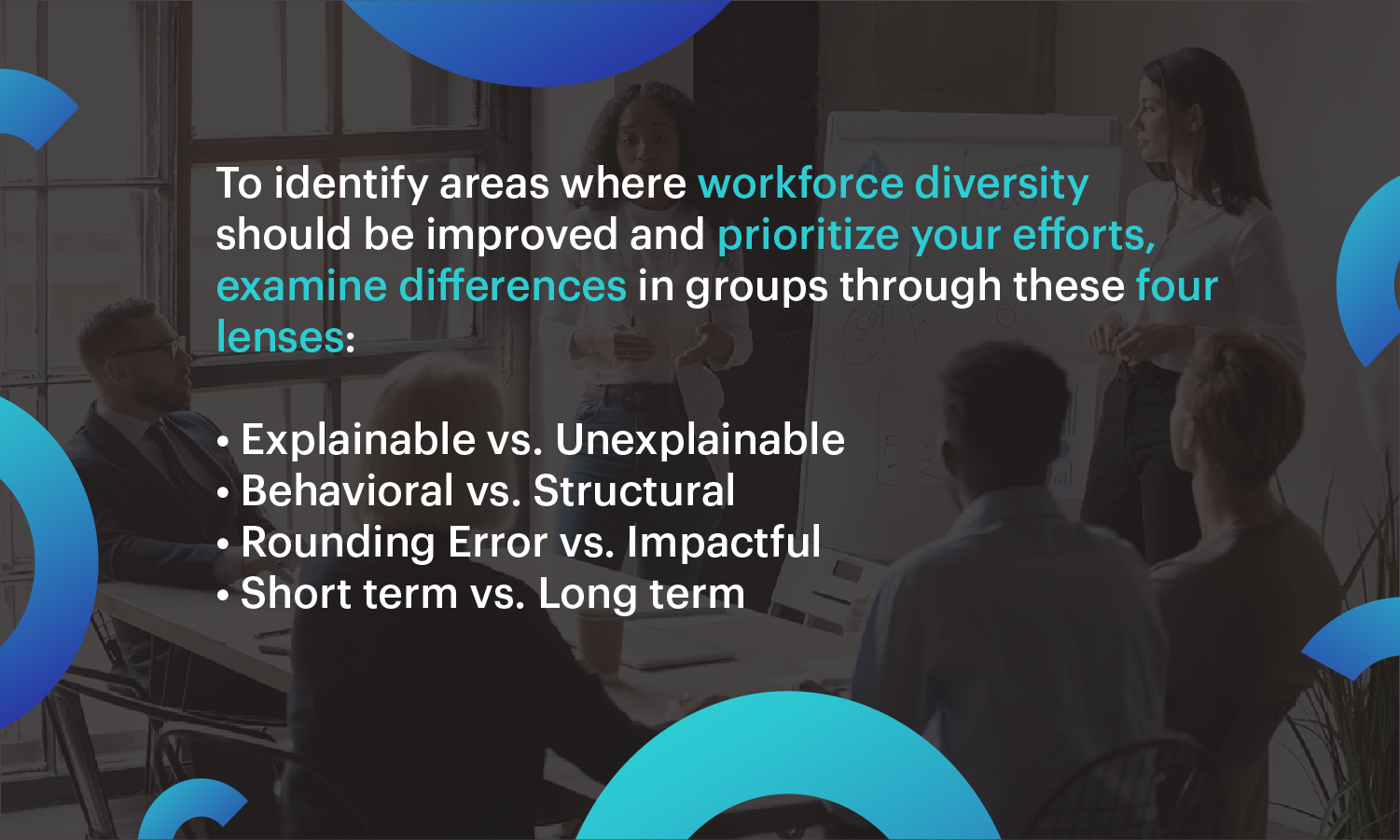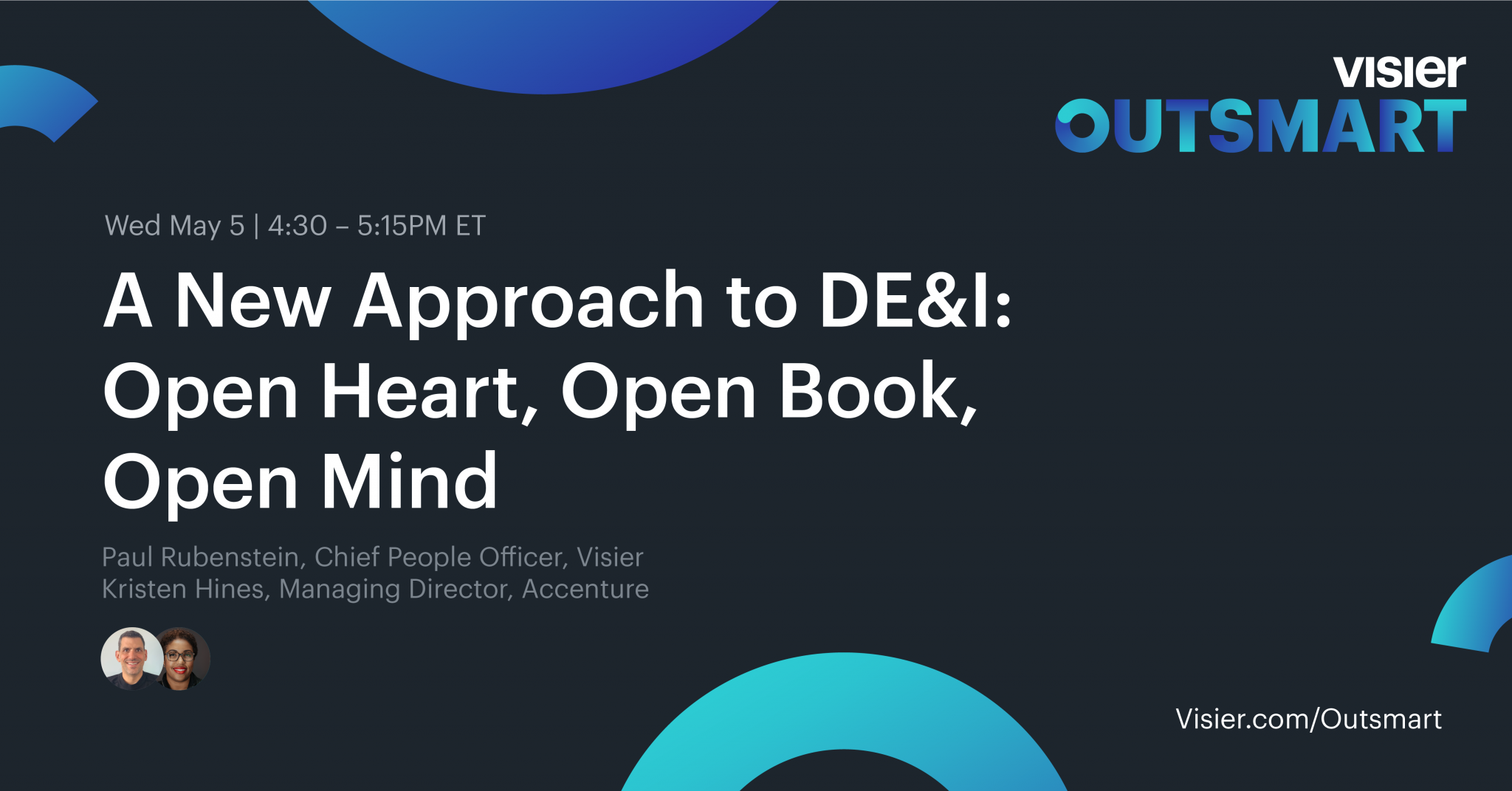How to Use People Data to Drive D&I Accountability (Get Beyond Good Intentions, Part 2)
With this 3-step guide gain an understanding of what it takes to spot D&I problems, set the right goals, and build accountability using people analytics.

Outsmart, the leading people analytics and workforce planning conference, takes place online on May 5-6, 2021. It’s free to register so save your spot today! At Outsmart, the author of this article, Paul Rubenstien, Visier’s Chief People Officer, will lead a discussion with Kristen Hines, Managing Director, Accenture on the Open Heart, Open Book, Open Mind framework. Come back everyday leading up to the conference for more great insights like this. Enjoy!

In part 1 of this article, you were introduced to Visier’s framework for moving the needle on D&I. A core element of this approach is what we call Open Book—the use of data and rich insights to make better decisions that support a more diverse and inclusive workplace.
The Open Book approach is rooted in the belief that accountability is shaped by the connection between your actions and the data you encounter.
When you drive to work, for example, how fast you choose to drive is determined by the inputs from your speedometer, the speed limit, and your watch. Each month, your P&L statement shapes the choices you make around spending, hiring, or discounting sales. How your decision shows up in data weighs heavily on the decision you make.
Data can be used to overcome the biggest enemy of change: human inertia.
The adoption of new mindsets and new behaviors around hiring and promotions needs to overcome past practice and the human instinct to avoid pain. Imagine being a high-volume production manager. The continuity of this week’s production, avoiding overtime or a great time-to-fill metric are the data elements that are most frequent and loud in the flow of your work.
The once-a-year infographic on overall representation of women and minorities doesn’t effectively shape your hiring decision. For data to effectively shape workforce outcomes, it needs to:
Spot a problem in a specific way
Be relevant and available to a decision moment that matters
Be visible in a way that drives accountability

3 steps to driving D&I accountability with your people data
Let’s dive into the “how-to” of Open Book of Visier’s framework so you can gain an understanding of what it takes to spot problems, set goals, and build accountability using people analytics.
Step 1: Get granular to see why representation gaps exist–and persist
I often hear people say “we have a diversity problem,” without understanding what their problem is and whether it is addressable. Looking at your overall data and saying a certain group is under-represented is a start.
But then it’s time to dig in. Be curious about the different dimensions that shape workforce representations, including hiring manager, geography, job level, job type, compensation, tenure, development programs attended, performance ratings, etc.
To identify problem areas and how they should feature on your organization’s priority list, examine differences in groups through these four lenses:
Explainable vs. Unexplainable
Start by determining what you can and cannot explain. Is a certain demographic experiencing a challenge that is preventing you from having a more diverse workplace? Is this due to a specific hiring practice? Or is it something about the labor market that is harder to define? It is better to label something as unexplainable and be conscious of where you are making assumptions than assign it the wrong cause entirely.
Behavioral vs. Structural
Some imbalances in the workforce are really about labor supply differences. It is common for technology firms to be frustrated by the fact that there aren’t graduates from specific demographics. Other differences, however, might be an indication of individual actors, behaviors, or attitudes within the organization.
Understanding what is behavioral vs. structural is the key to meaningful action. Focusing exclusively on anti-bias training, for example, will only get you so far if there are market factors to consider. These differences are not an “excuse,” but they should shape an objective view of where to focus efforts and measure progress.
Rounding Error vs. Impactful
You not only need to understand the nature of the problem, you need to consider whether an intervention would make a meaningful difference. For example, reaching certain labor pools might require you to go into unsustainable telecommute situations that are not suitable for the job type, which may end up leading to turnover of diverse team members in the end. Analyzing this dimension is very helpful when assessing investments.
We often see organizations embark on feel-good investments that sound nice, but can be matched to the loudest problem rather than the largest one. This dimension of analysis helps create a balanced discussion.
Short term vs. Long term
Think about the timeframe that you can place over a change. Is this a change that you can make today, like a procedural change such as removing the college degree requirement, or is this something that might take years of investing in a training program? Knowing this will help you determine what kind of effort is required to meet a certain goal, and how soon you should expect to see results.

Step 2: Use goals and targets (not quotas)
Once you understand your root causes, it’s important to set your organization’s North Star—this will orient all your efforts.
If you have followed step one, you will have a precise view of where your workforce challenges are. This, in turn, will allow you to be very specific about setting targets and goals, which will hold people accountable for making better decisions.
Holding people accountable for changing the composition of the workforce will often bring up a discussion about quotas. The problem with quotas is they drive compliance, but don’t ensure authenticity, inclusion, or meaningful outcomes.
Quotas that put outcomes ahead of individual talent can be unhealthy, but targets can drive individual decision-makers to bring their actions into alignment. This approach is successful when you have the mindset that hiring diverse people doesn’t mean compromising on talent quality.
At Visier, we are explicit about this: we want everyone to make choices that give Visier an employee population that is both talented AND diverse—no compromises. To do this, we use two words: Targets and Goals.
Targets are where accountability for an outcome is diffused, and not all the elements are within our control. Example: Visier has a 5-year target for gender parity in our people managers, and a target for each year on that path.
The choices we make are within our control—the labor market is not fully within our control. We are, however, accountable to drive change. We make the hiring targets visible to all, not unlike looking at the metrics for salesperson targets. And just like sales, each person has an individual target, but if the company does not make the overall number, then nobody really wins.
Goals are for items where accountability for an outcome can be easily assigned, and all the elements are within our control. Example: At Visier, we will have diverse interview panels starting tomorrow.
Goals are great for reinforcing behaviors, driving impact through de-biased processes and important for driving short-term change. These are especially useful for driving accountability for Open Mind or Open Heart programs (see Part 1 of this article).

Step 3: Build a rhythm of accountability
Create a rhythm around accountability by sharing data on a regular basis. It’s important to create a rhythm of data so that a non-change or negative change keeps people motivated to do things differently, and when it does change in a positive way, you can celebrate the improvement.
There are two distinct rhythms to create: one that mimics your financial reporting and another that happens alongside a decision.
First rhythm: Reflect and correct
The established norm of reviewing monthly and quarterly business results should include progress on talent issues—including measures of diversity, equity, and inclusion.
A set of numbers, looked at collectively, is hard to ignore. Go two months in a row without making progress on a goal, and you might not face huge consequences. Go three months with no rational explanation or course-correction, and you risk embarrassment. Go more than two quarters, and your credibility gets challenged directly by the CEO. Visibility and repetition of workforce representation goals are foundational to creating a culture of accountability for change.
Each organization has their own language around goal setting and measurement. At Visier, we set Objectives and Key Results (OKRs) to manage our business. This year we have an OKR specific to diversity: Close the gap in female representation among people managers.
Place your DE&I objectives into the same management rhythm as your major objective, but never review less frequently than your monthly P&L. Some suggestions:
With your CEO and a minimum of two levels below:
Review progress monthly against workforce representation targets, and overall workforce composition. If you set goals around process changes or program participation, then report those also.
With all employees:
At least twice a year, formally share your progress against goals—both good and bad. This helps everyone within the organization understand that they have a role in driving change.
At least twice a year, remind people of your pay equity practices. You don’t need to share personal data. Share the practices you undertake and re-affirm your commitment. We do pay equity analysis twice a year. If something is off by more than 5% and is unexplainable, we correct it.
Externally to shareholders, partners, customers, candidates, and community:
At least once a year, help everyone understand the diversity of your workforce and any targets you have set in changing or sustaining that diversity.
While scary, this level of external transparency has two benefits. Firstly, it creates accountability internally around meeting commitments. Secondly, it creates an objective narrative about what your company does, and is willing to do about diversity, equity and inclusion.
All of this transparency builds trust. It empowers those who champion change and creates positive social pressure on those who slow it down.

Second rhythm: In the Flow of Work
Well-curated and well-timed people analytics change the outcome of a single hiring, promotion, and development decision. Do that enough times and you have a trend. Sustain that trend and you have lasting change.
Many day-to-day decisions about people are about solving an immediate problem. Bringing data into the flow of that decision can connect it to the CEO’s strategy. Think of it as using these analytics as a way of reminding people to balance the important with the urgent—to connect a small moment to a collective outcome.
Without those analytics, people tend to revert to what they know, or the path of least resistance. Humans are now conditioned to check Waze before going for a drive, for example. This same thing can happen for talent decisions if the data is relevant and accessible.
Here are some moments that would benefit from having DE&I data in the flow of work:
Alongside promotion cycles
Before and after bonus cycles
At the start and close of hiring processes
Alongside succession planning discussions
Alongside development program nominations

Make your technology and corporate culture work together
Change is never easy, but the good news is that answering your most pressing workforce questions with data has never been easier–and the insights have never been richer. In the past, people analytics was reserved for one or two innovators chasing moonshot projects, but now it is simple for organizations to deliver at scale.
Technology alone won’t achieve social justice, but meaningful insights delivered within the right corporate culture will move us in the right direction—and it’s not too late to get started.
Hear more from Paul on this topic at Outsmart on Wednesday, May 5 at 4:30-5:15pm EST in A New Approach to DE&I: Open Heart, Open Book, Open Mind, with Kristen Hines, Managing Director at Accenture. Register for the free digital conference today!

Get Outsmart content straight to your inbox
Subscribe to the People Insights Monthly newsletter for actionable insights and stories.
Subscribe now